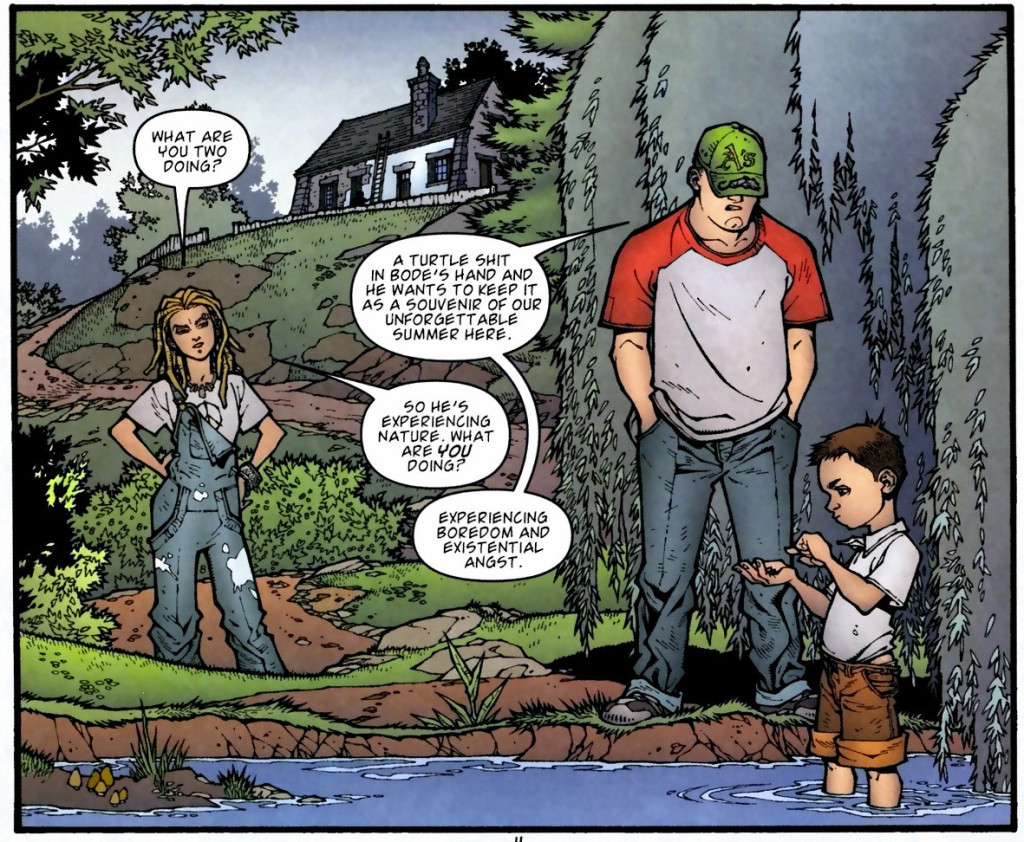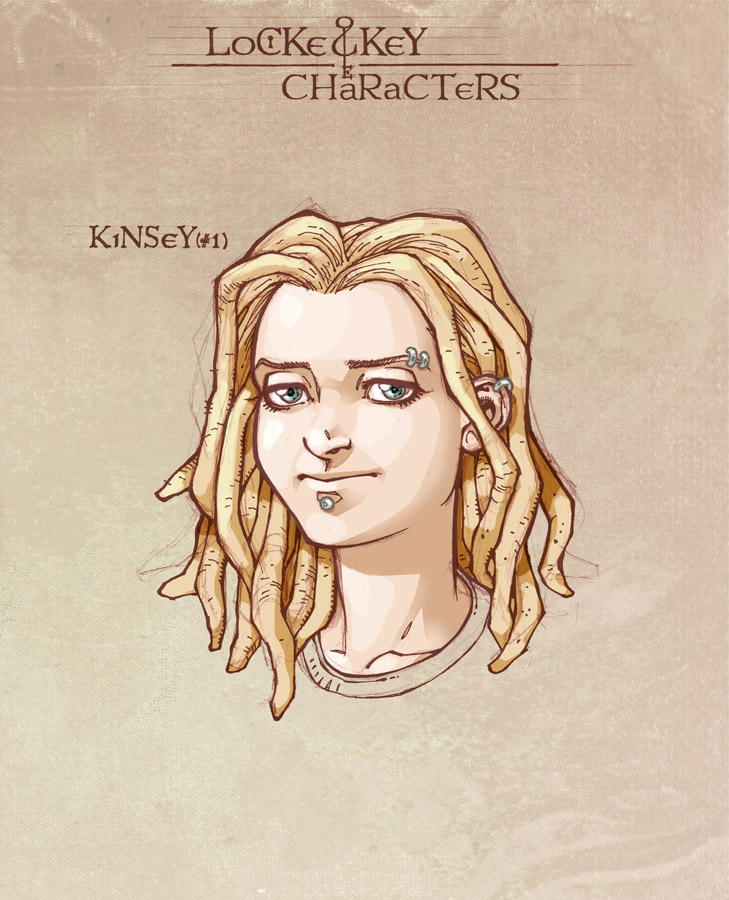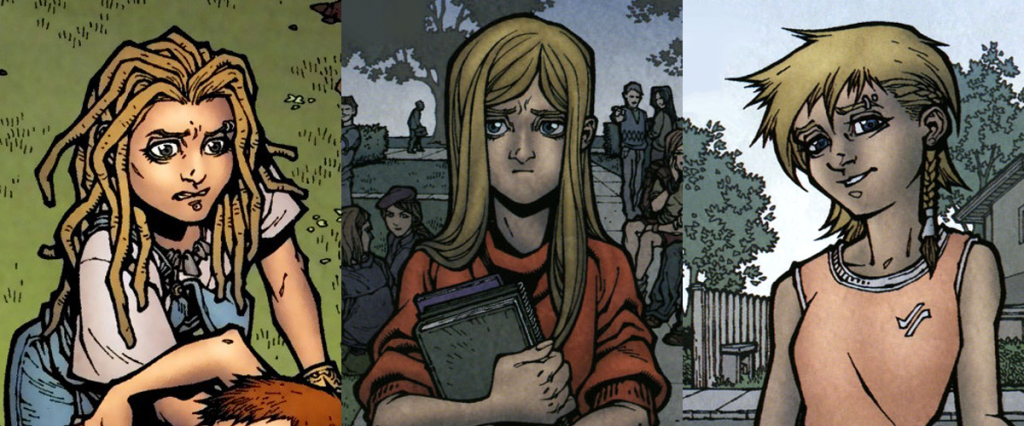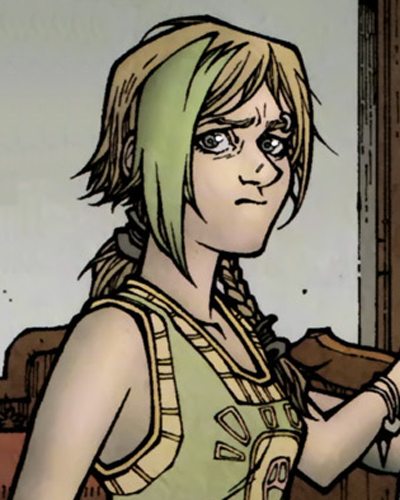Please welcome our newest guest blogger, Sam!
Last year at C2E2 I picked up volume one of Locke & Key by Joe Hill and Gabriel Rodriguez. I had been meaning to read it for months, ever since I started following Joe Hill on Twitter, but didn’t really know what it was about except for the basics. I was astounded at the horrific scene that greeted me when I opened the book, but even more so at the nuanced way Hill and Rodriguez presented the story of the main characters’ coping in the aftermath of tragic events.

Kinsey, Tyler and Bode. Image via TopFiveComics
After the gruesome murder of their father, the Locke children (Tyler, Kinsey and Bode) and their mother move to the family estate in Lovecraft, Maine. The main story is about the Keyhouse, their mansion, that holds a great secret in the form of keys that have the power to do just about anything, such as allowing them to grow wings and fly. But not all is peaceful in their new home, as there is a lurking spirit that has haunted the Locke family since their father lived in the Victorian manor. Dodge, the vicious entity, charms young Bode into releasing it from its prison. What follows is a brutal battle between Dodge and the Locke children for power over the Omega key. (Possible spoilers ahead.)
Hill and Rodriguez don’t pull any punches when it comes to this story. The reader is immediately thrown into one of the Locke family’s greatest tragedies. It’s no surprise that the kids, witnesses to their father’s murder, would be changed forever. Tyler is the eldest, the protector of the family, and he is hit seemingly the hardest, having heard the gunshots that signaled his father’s death. His struggle makes sense considering he came face to face with the killers and went to school with the instigator, Sam Lesser, so he also feels guilt because he believes he caused his father’s death in the first place. Bode is the youngest and seems to understand that his father is gone but not the consequences of the actions of his killers. And then there is Kinsey.

Kinsey, before moving to Lovecraft. Image source: Gabriel Rodriguez
Kinsey struck me almost immediately. She saved Bode by hiding up on the roof and keeping him quiet while Tyler and their mother stayed below, dealing with the attackers in the house. It is said that victims of trauma and assault tend to change their appearance in order to keep some semblance of control. (The linked article on stages of coping after rape is very informative but may be triggering.) Interestingly enough, it isn’t her mother who makes those changes, but Kinsey. Initially, it’s an excuse to blend in at her new school, saying that it is better to fit in at a place like Lovecraft Academy if she looks like everyone else. At first, she gets rid of her dreads, and then her piercings, and changes her clothes to something seemingly normal.
This first change surprised me, although not as much as the next few. Normalizing her hair and clothes seemed natural, even though Kinsey does not appear like the kind of girl who wants to fade into the background. But this change actually makes sense, given the fact that Kinsey survived by hiding and staying quiet. In order to get through her new life and new school, she falls back on the survival instinct to disappear in the crowd.
Her new, forgettable look doesn’t last long. After she gets acclimated to Lovecraft Academy and joins the track team, Kinsey takes control once more. Her normal hair is cut and braided into a not so conventional style. It’s another change that is a lot more dramatic than attempting to be normal. Right before she makes this change, she even states, “I’ll probably spend the rest of my life looking out windows for Sam Lesser and jumping at every strange face I see, whether they catch him or not. I’m not going to jump when I see my own face.”

Kinsey, before moving to Lovecraft, after moving to Lovecraft, and then after adapting to her new environment. Image source: Locke & Key wiki
Kinsey’s gradual transformation made me realize how much attention Hill and Rodriguez make sure to pay to what happens to trauma survivors. The story could have easily focused just on Mrs. Locke’s alcoholism as a coping mechanism, or Tyler’s depression, or even little Bode’s ability to escape into his own world. Instead, they added in Kinsey’s changes as a subtle but very powerful indication of what she’s gone through.
Her new hairstyle screams “I’m taking control!” Kinsey even does it herself, something most girls (myself included) only think about doing in frustration, but then end up making an appointment with the hairdresser. She’s tired of being surprised every time she looks in the mirror, and she realizes that what she’s done to make herself look normal is wipe away everything that is “her” in the process. It’s not fair to allow Sam Lesser of all people to take her appearance away from her and it’s the only thing Kinsey can control. She has no power over the fact that the family has moved across the country to the Keyhouse, and she doesn’t have a lot of control when it comes to her new school or her brothers, but she can be in charge of her appearance and her identity.
Unfortunately, the Locke family isn’t entirely safe after they move to Keyhouse. Sam Lesser, with a little bit of help from Dodge, escapes prison and lurches into Lovecraft to find the remaining survivors of his first slaughter. Kinsey is directly assaulted in Sam’s second attack on the family, nearly dying in the chaos. The Locke family manages to fend off and get rid of their tormentor, but not without more physical and emotional scarring.
Kinsey dyes her bangs after Sam Lesser’s final attack on the Locke family and it is the strongest of the changes. This step is not so much about her identity but about her physical body more than anything else. Even though it’s the most subtle change in her looks, it still signifies just how much she needed to take control of the situation, after Sam attempted to take away her life and her being.
That’s not to say that Kinsey is done regaining control over her life. While her appearance changes trickle off after the first volume, Kinsey continues to assert herself in later volumes, with the help of the Keyhouse manor’s secrets. Hill and Rodriguez really left an impression on me by putting Kinsey’s coping mechanisms in the story in such a realistic, accurate way. She could have easily spiraled into a withdrawn victim who locked away her fears and didn’t confront them. Sure, her past still haunts her, but her response is a natural one that isn’t shown very often in mainstream media, making me appreciate Locke & Key even more.


